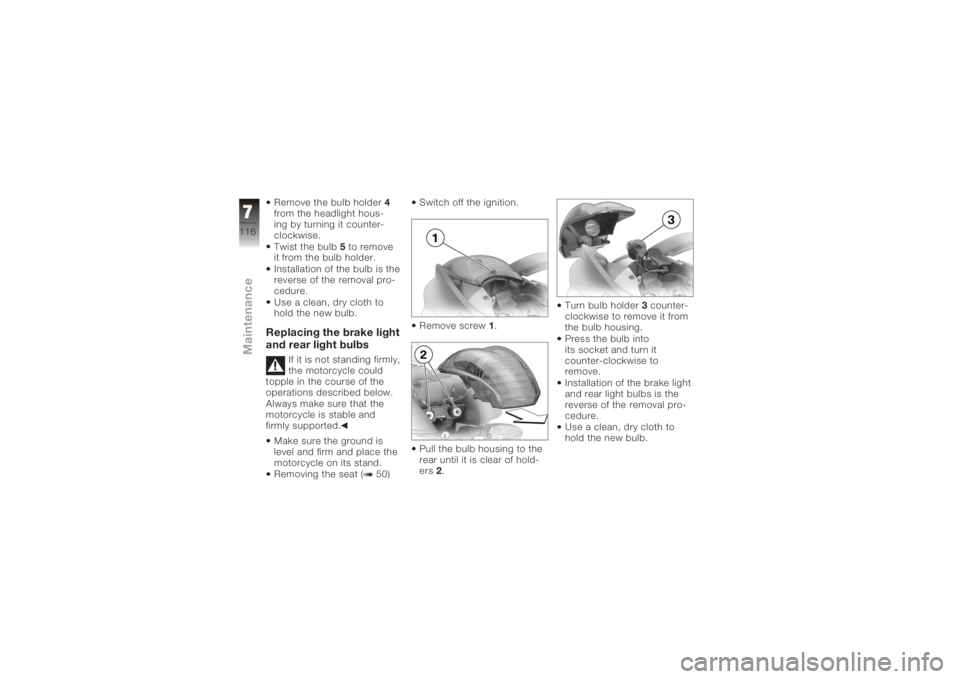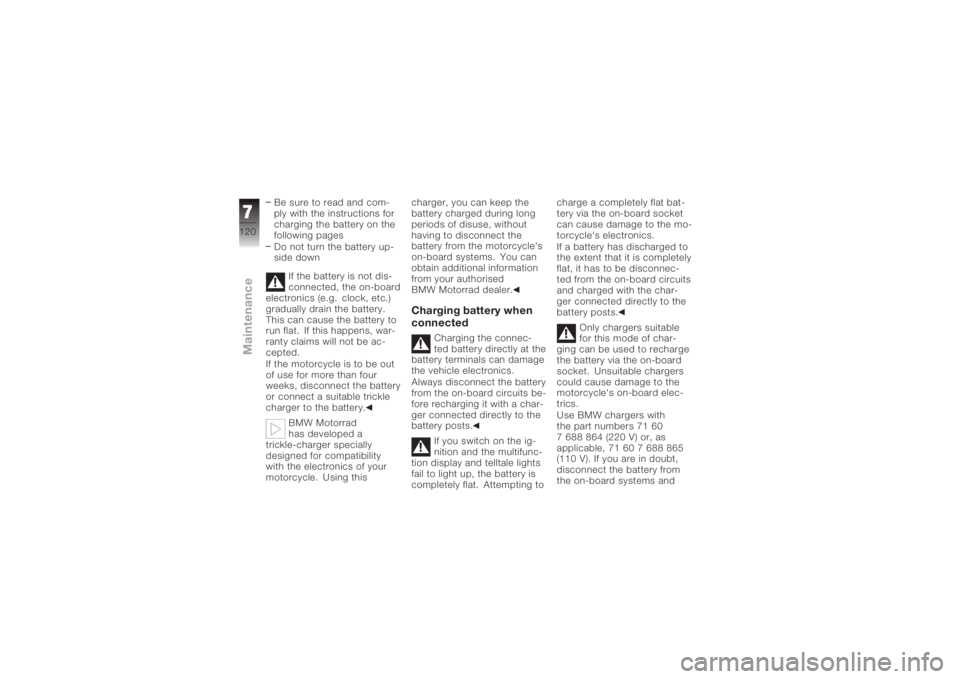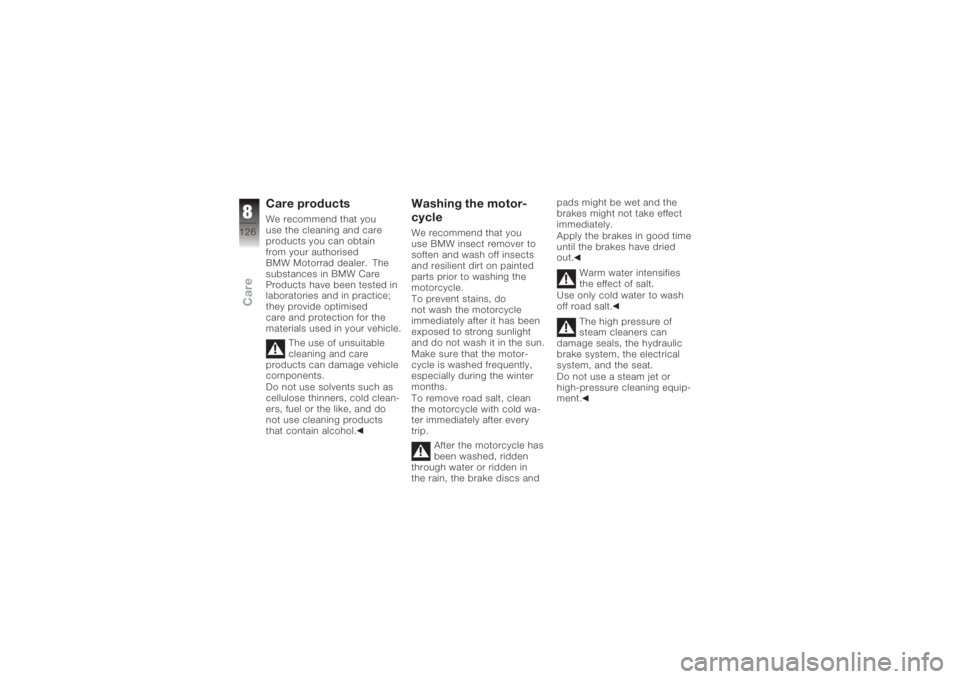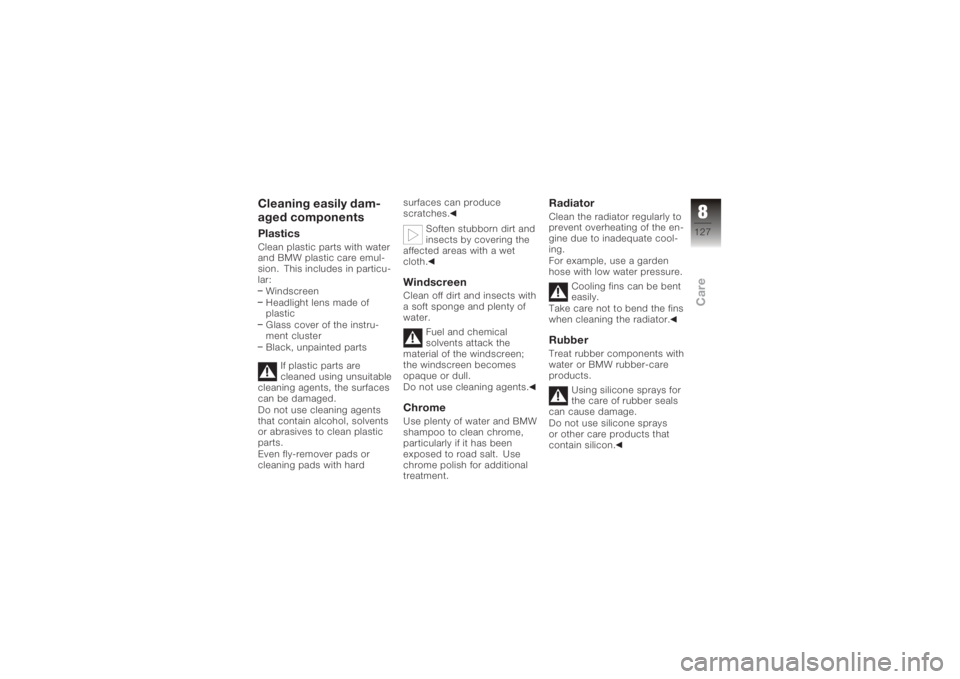Page 118 of 165

Remove the bulb holder4
from the headlight hous-
ing by turning it counter-
clockwise.
Twist the bulb 5to remove
it from the bulb holder.
Installation of the bulb is the
reverse of the removal pro-
cedure.
Use a clean, dry cloth to
hold the new bulb.Replacing the brake light
and rear light bulbs
If it is not standing firmly,
the motorcycle could
topple in the course of the
operations described below.
Always make sure that the
motorcycle is stable and
firmly supported.
Make sure the ground is
level and firm and place the
motorcycle on its stand.
Removing the seat ( 50) Switch off the ignition.
Remove screw
1.
Pull the bulb housing to the
rear until it is clear of hold-
ers 2. Turn bulb holder
3counter-
clockwise to remove it from
the bulb housing.
Press the bulb into
its socket and turn it
counter-clockwise to
remove.
Installation of the brake light
and rear light bulbs is the
reverse of the removal pro-
cedure.
Use a clean, dry cloth to
hold the new bulb.
7116zMaintenance
Page 122 of 165

Be sure to read and com-
ply with the instructions for
charging the battery on the
following pages
Do not turn the battery up-
side downIf the battery is not dis-
connected, the on-board
electronics (e.g. clock, etc.)
gradually drain the battery.
This can cause the battery to
run flat. If this happens, war-
ranty claims will not be ac-
cepted.
If the motorcycle is to be out
of use for more than four
weeks, disconnect the battery
or connect a suitable trickle
charger to the battery.
BMW Motorrad
has developed a
trickle-charger specially
designed for compatibility
with the electronics of your
motorcycle. Using this charger, you can keep the
battery charged during long
periods of disuse, without
having to disconnect the
battery from the motorcycle's
on-board systems. You can
obtain additional information
from your authorised
BMW Motorrad dealer.
Charging battery when
connected
Charging the connec-
ted battery directly at the
battery terminals can damage
the vehicle electronics.
Always disconnect the battery
from the on-board circuits be-
fore recharging it with a char-
ger connected directly to the
battery posts.
If you switch on the ig-
nition and the multifunc-
tion display and telltale lights
fail to light up, the battery is
completely flat. Attempting to charge a completely flat bat-
tery via the on-board socket
can cause damage to the mo-
torcycle's electronics.
If a battery has discharged to
the extent that it is completely
flat, it has to be disconnec-
ted from the on-board circuits
and charged with the char-
ger connected directly to the
battery posts.
Only chargers suitable
for this mode of char-
ging can be used to recharge
the battery via the on-board
socket. Unsuitable chargers
could cause damage to the
motorcycle's on-board elec-
trics.
Use BMW chargers with
the part numbers 71 60
7 688 864 (220 V) or, as
applicable, 71 60 7 688 865
(110 V). If you are in doubt,
disconnect the battery from
the on-board systems and
7120zMaintenance
Page 124 of 165
Disconnection in
the wrong sequence
increases the risk of
short-circuits.
Always proceed in the correct
sequence.
Disconnect negative lead 2
first.
Then disconnect positive
lead 3. Remove screws
4and pull
the retainer to the rear.
Lift the battery up and out;
work it slightly back and
forth if it is difficult to re-
move.
Installing battery
If it is not standing firmly,
the motorcycle could
topple in the course of the
operations described below.
Always make sure that the
motorcycle is stable and
firmly supported. Make sure the ground is
level and firm and place the
motorcycle on its stand.
Switch off the ignition.
Place the battery in the bat-
tery compartment, positive
terminal on the right in the
forward direction of travel.
Slip the battery retainer
over the battery and install
screws
4.
7122zMaintenance
Page 128 of 165

Care productsWe recommend that you
use the cleaning and care
products you can obtain
from your authorised
BMW Motorrad dealer. The
substances in BMW Care
Products have been tested in
laboratories and in practice;
they provide optimised
care and protection for the
materials used in your vehicle.The use of unsuitable
cleaning and care
products can damage vehicle
components.
Do not use solvents such as
cellulose thinners, cold clean-
ers, fuel or the like, and do
not use cleaning products
that contain alcohol.
Washing the motor-
cycleWe recommend that you
use BMW insect remover to
soften and wash off insects
and resilient dirt on painted
parts prior to washing the
motorcycle.
To prevent stains, do
not wash the motorcycle
immediately after it has been
exposed to strong sunlight
and do not wash it in the sun.
Make sure that the motor-
cycle is washed frequently,
especially during the winter
months.
To remove road salt, clean
the motorcycle with cold wa-
ter immediately after every
trip.
After the motorcycle has
been washed, ridden
through water or ridden in
the rain, the brake discs and pads might be wet and the
brakes might not take effect
immediately.
Apply the brakes in good time
until the brakes have dried
out.
Warm water intensifies
the effect of salt.
Use only cold water to wash
off road salt.
The high pressure of
steam cleaners can
damage seals, the hydraulic
brake system, the electrical
system, and the seat.
Do not use a steam jet or
high-pressure cleaning equip-
ment.
8126zCare
Page 129 of 165

Cleaning easily dam-
aged componentsPlasticsClean plastic parts with water
and BMW plastic care emul-
sion. This includes in particu-
lar:Windscreen
Headlight lens made of
plastic
Glass cover of the instru-
ment cluster
Black, unpainted parts
If plastic parts are
cleaned using unsuitable
cleaning agents, the surfaces
can be damaged.
Do not use cleaning agents
that contain alcohol, solvents
or abrasives to clean plastic
parts.
Even fly-remover pads or
cleaning pads with hard surfaces can produce
scratches.
Soften stubborn dirt and
insects by covering the
affected areas with a wet
cloth.
WindscreenClean off dirt and insects with
a soft sponge and plenty of
water.
Fuel and chemical
solvents attack the
material of the windscreen;
the windscreen becomes
opaque or dull.
Do not use cleaning agents.ChromeUse plenty of water and BMW
shampoo to clean chrome,
particularly if it has been
exposed to road salt. Use
chrome polish for additional
treatment.
RadiatorClean the radiator regularly to
prevent overheating of the en-
gine due to inadequate cool-
ing.
For example, use a garden
hose with low water pressure.
Cooling fins can be bent
easily.
Take care not to bend the fins
when cleaning the radiator.RubberTreat rubber components with
water or BMW rubber-care
products.
Using silicone sprays for
the care of rubber seals
can cause damage.
Do not use silicone sprays
or other care products that
contain silicon.
8127zCare
Page 142 of 165
Lighting
High-beam headlight bulb, standard designa-
tionH7 halogen bulb
High-beam headlight bulb, voltage 12 V
High-beam headlight bulb, power 55 W
Low-beam headlight bulb, standard designa-
tion H7 halogen bulb
Low-beam headlight bulb, voltage 12 V
Low-beam headlight bulb, power 55 W
Parking light bulb, standard designation W5W
Parking light bulb, voltage 12 V
Parking light bulb, power 5 W
Tail light / brake light bulb, standard designa-
tion P21W
Tail light / brake light bulb, voltage 12 V
Tail light / brake light bulb, power 21 W
Front flashing turn indicator bulbs, standard
designation W16W
Front flashing turn indicator bulbs, voltage 12 V
Front flashing turn indicator bulbs, power 10 W
9140zTechnical data
Page 143 of 165
Number-plate light bulbIntegrated in rear lightFrameMain frame, typeComposite with internal-high-pressure forming
and extruded sections and chill castings
Type plate, location Frame cross-tube, rear
Vehicle identification number (VIN), location Frame side section, front rightDimensionsOverall motorcycle length 2182 mm
Maximum width 905 mm, Across mirrors
Maximum height 1211 mm, DIN unladen weight
Seat height, front 820 mm, Without rider
with OE Front seat, low: 790 mm, Without rider
Wheelbase in normal-load position 1571.64 mm, Full load of fuel, with
rider: 85 kg
Ground clearance 144 mm, In normal-load position, full load of
fuel, with rider: 85 kg
9141zTechnical data
Page 156 of 165

A
Abbreviations and symbols, 6
Anti-theft alarm, 17
B
BatteryCharging battery when
connected, 120
Charging the battery when
disconnected, 121
Installation, 122
Removal, 121
Warning, battery charge
current, 26
Brake fluid Checking level, front, 97
Checking level, rear, 98
Brake pads Checking front, 95
Checking rear, 96
Brakes Technical data, 138
Breakdown assistance kit, 89 Bulbs
General instructions, 112
Replacing brake-light
bulbs, 116
Replacing front turn
indicator bulb, 117
Replacing high-beam
headlight bulb, 114
Replacing low-beam
headlight bulb, 112
Replacing parking-light
bulb, 115
Replacing rear light
bulbs, 116
Replacing rear turn indicator
bulb, 117
Technical data, 140
Warning, bulb failure, 26, 27
C
Case Adapting, 89
Adjusting, 86
Closing, 86
Installing, 88 Opening, 86
Removing, 87
Clock, 20 Adjusting, 17, 44
Clutch Fluid reservoir, 11, 13
Technical data, 136
Confirmation of maintenance work, 147
Coolant Temperature gauge, 21
Warning, coolant temperat-
ure, 24
E
Electrics Technical data, 139
Emergency off switch (kill switch), 16, 45
Engine Technical data, 134
Temperature gauge, 20
Warning, engine electron-
ics, 25
11154zIndex